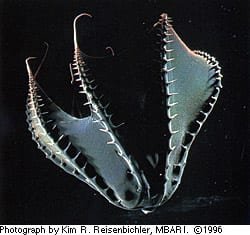The Twilight Zone’s Vampire





I love this week’s animal. It looks devilish but this little cephalopod is just a big softie (both literally and figuratively). Let’s dive into the lightless depths and meet the wonderful Vampire squid!
What is it? Great question….umm, well this little cephalopod has a long history of being misidentified. At first they were identified as an octopus, then a squid, but now scientists have decided that the vampire squid do not fit either category. The vampire squid now is sitting comfy in its own order called Vampyromorphida. They are around the size of a football and look like a Beanie Baby demon octopus (like you know it’s supposed to be scary, but it’s kinda cute). They are a red to a black color because red is the first color to disappear in water, so it acts as deep sea camouflage. They have big clear eyes, that appear blue when light hits them. They have 8 arms with webbing between them called a cloak, and two long tentacles used for food. Unlike most squid, the vampire squid has spines instead of suckers. It really adds to the spooky factor. Though we aren’t exactly sure how long they live, scientists believe our underwater vampire friend can live up to 10 years.
Where do you find vampire squid? Like regular vampires, the vampire squid doesn’t live where the sun can reach it. They live in the mesopelagic zone often referred to the Twilight zone (I know, more vampire references), and can be frequently found in the oxygen minimum zone, around 2,000-3,000ft. Vampire squid are found circumglobally in tropical and temperate waters.
What do they eat? Blood…. I wish (sorta) but no. Vampire squids are what scientists call a detritivore. This means their preferred meal is detritus, which is literally dead organic material floating in the water. To make it sound nicer, this deep sea detritus is called Marine Snow, since a majority of it floats down from closer to the surface. Their tentacles are sticky which collects all the detritus. They don’t need much to keep them going since they literally just go with the flow and float along. Minimal effort never looked so good.
What does vampire dating look like? Funny story… we’re not too sure. They live pretty far down in the ocean, and aren’t the easiest animal to observe. Scientists believe that the vampire squid is slow when it comes to reproduction. They are spread out and when a male runs into a female, he will offer her a little packet of sperm, which she will store away in a special pocket in the mantle till she’s stored up enough nutrients to lay eggs. So considerate. When the female is ready, she will lay a small number of large eggs. They will hatch…eventually into tiny versions of the adults. We do know they go through 3 growth phases. So, you know, the typical squid meets squid romance.
What are vampire squid super powers? They can really glow! I mean, they have great personalities, but they actually glow. All along their skin, especially the tentacles, are light producing organs called photophores. These lights are able to create bright, disorienting flashes to scare off predators, but what is really nifty is that they can modulate the intensity and length of the flash. If that wasn’t enough, the vampire squid has 2 white spots on the top of their mantle that scientists thought were photophores, but recently it has been discovered they are actually photoreceptors aka simple eyes! How cool is that?! Speaking of eyes, vampire squid have the biggest eyes in relation to body size. They are pretty amazing. Lastly they have a signature move when scared, and it has the cutest name ever…Pineapple pose!! It’s too cute, and their version of hiding under the blanket…a really spikey blanket. They pull up their tentacles and hide in a cocoon of their cape and spikes. Here’s a photo for you to enjoy.
How many are there? Once again, we aren’t too sure, but since they live so far down they’re not overly affected by us. Yay them!
Science Time!!
Vampire Squid - Vampyroteuthis infernalis
The name literally translates to “vampire squid from hell” but as we covered earlier, these sweet angel babies don’t have a mean bone in their body. Well literally and figuratively… they don’t have bones, but also energy is precious in the depths, thus they don’t waste it on fighting. The most peaceful of vampires really.
So this is a first, but there is no IUCN Red List classification since they are not affected by industry, by-catch, or really any human thing which is great for them. In place of the usual IUCN classification, I will leave you with this jaunty little illustration that makes the vampire squid look really…..spooky. Enjoy and see you next week!
Resources:
Aquarium of the Pacific. (n.d.). Vampire squid. Online learning center: Species. https://www.aquariumofpacific.org/onlinelearningcenter/species/vampire_squid
Monterey Bay Aquarium (n.d.). Vampire squid. Animals. https://www.montereybayaquarium.org/animals/animals-a-to-z/vampire-squid
Monterey Bay Aquarium Research Institute. (2024). Vampire squid, Vampyroteuthis infernalis. Animals. https://www.mbari.org/animal/vampire-squid/


